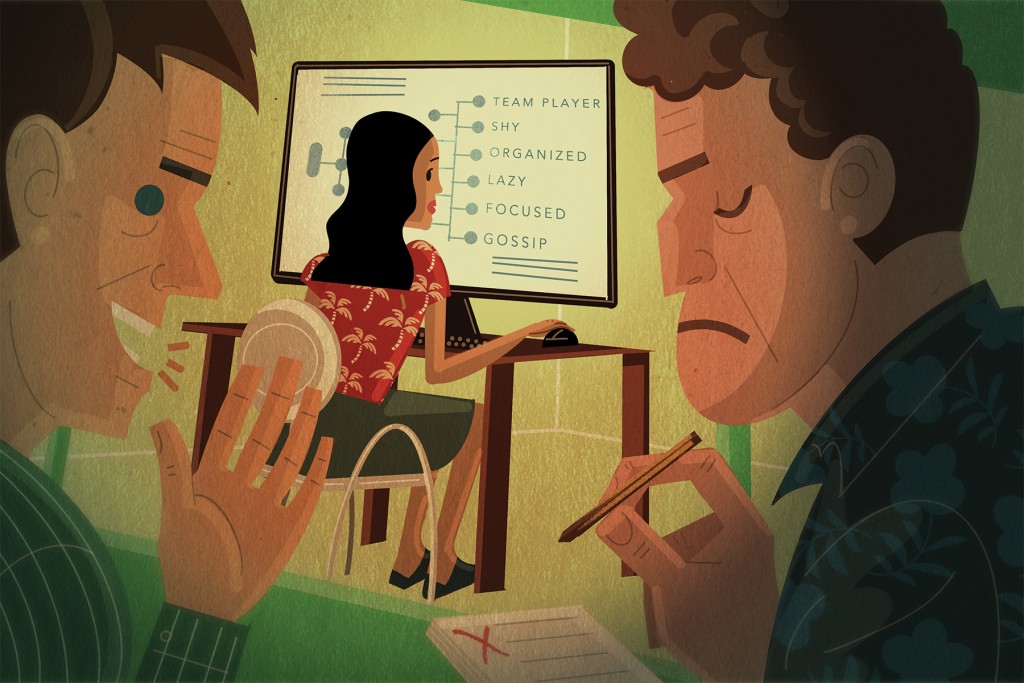Tracking Your Personality

As more companies assess their employees’ personalities, there are ways to reassure workers and use the test results to help everyone
Q: On one of the first days at my new job, I was given a personality test. I thought it was a census-type thing for the corporate head office, so I took it quickly and didn’t think more about it. I was taken aback when the office manager shared the results with me the next day, having already sent them to my supervisor. I haven’t heard more from either of them but it still makes me uneasy. Is this a normal use of a personality test?
A: Did you know that statistically, you’re most likely to encounter a Gryffindor personality type in Hawaii, compared to all other states? Luckily, they are known for courage and kindness. I know this because Time magazine did an online 21-question personality-trait quiz based on the houses in the “Harry Potter” series – and slotted each test taker the way the Sorting Hat places students into Gryffindor, Ravenclaw, Hufflepuff or Slytherin. Time’s quiz wasn’t magic; it’s actually based on the work of social scientists and used data from other standard personality tests. I took the quiz and was relieved not to be a candidate for the House of Slytherin. But that is very different from an employer imposing a test without my buy-in.
Personality and behavior assessment tests have become popular tools in the workplace, says Nelson Befitel, chief counsel at ProService Hawaii, an HR management firm headquartered in Hawaii Kai. He says employers use the tests to help them better understand their employees, from their strengths and preferred communication styles, to how they might resolve conflict. In fact, at ProService Hawaii, “we have every new employee, regardless of level, take the Gallup CliftonStrengths assessment, which helps individuals identify, understand and maximize their strengths within the workplace,” he says.
“A good manager will use the (test) results to identify areas in which you may excel as well as what they can do to help you succeed.”
– Nelson Befitel, Chief counsel, ProService Hawaii
But it’s important to share the goal behind an assessment, as well as how results may be used. “Questions such as, ‘Who will the results be shared with?’ and ‘Will this influence how I’ll be perceived in the company?’ must be addressed to reassure employees that the assessment won’t negatively impact their position at the company,” he says. “We dedicate a portion of our onboarding process to discussing the CliftonStrengths assessment, and we follow up with written materials that dive a little deeper into the background of the assessment and how it will be used on a daily basis.”
In light of this, having you take a personality test wasn’t a Muggle misfire; the misfire was the lack of transparency and clarity. Rest assured, though, as Befitel says such assessments are just a guide and do not paint a full picture of any employee. “As human beings, we’re complex creatures, and our personality and core strengths will evolve as we grow and learn new things. A good manager will use the results to identify areas in which you may excel as well as what they can do to help you succeed.” Even if you turn out to be a Slytherin.
━━
Q: Our company’s managers were coming up with new budgets for each program area and my office buddy seemed to struggle with his plan. I jumped in to help, hoping to share my expertise, but he got all weird. What went wrong?
A: From your perspective, you were trying to be a team player. From his side of the cubicle wall, he’s thinking, “Oh, shove a pie in it.” The disconnect stems from what type of help was being offered. According to the research I found from Michigan State University, there are two kinds of assistance: proactive help and reactive help. Proactive help is given before the helpee explicitly asks for it, and the results aren’t pretty. For one, the helper is going in clueless; that person doesn’t have a full read on the helpee’s actual problem and issues. Two, it harms the helpee’s self-esteem. Lastly, the helper is less likely to be thanked, which is what happened to you.
I asked Russell Johnson to elaborate on his research. Johnson is an associate professor in the Department of Management at MSU’s Broad College of Business and an expert on how motivation-, justice- and leadership-based processes affect work behavior. I was wondering: Does someone really need to wait for a verbal cry for help? Turns out, yes, and this is better for all involved.
“Our findings suggest that the mental drain on those who provide proactive or unsolicited help comes from having to continually monitor the environment for opportunities to offer help and figuring out what type of help is required,” says Johnson. “If employees do not make an explicit request for help, but rather do so indirectly via potentially ambiguous verbal and nonverbal cues, then it will still be a drain on helpers because they must devote time and attention to recognizing and decoding the meaning of the cues.” Everyone’s time, effort and ego will be better off if an explicit request for help is made before action is taken.
Managers can foster this in the workplace by creating a norm where it is OK to ask for help when needed, and the understanding that it is OK to focus on your own work until help is requested. “In other words, a manager can create a climate of reactive or solicited help in the workplace, which relieves employees from the time and effort of constantly looking for ways to provide proactive or unsolicited help,” says Johnson.
He also notes that “providing help creates less of a drain on employees when the help is acknowledged, and gratitude is expressed.” But, the gratitude does not necessarily have to come from the helpee. If a manager sees a helping exchange between employees, the manager can praise and thank the helper.
For more on this research, check out Michigan State University’s article, titled rather pointedly, “Keep To Yourself! Don’t Offer Co-Workers Help Unless Asked.” (tinyurl.com/waittohelp). Well, alrighty then.






